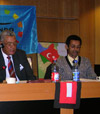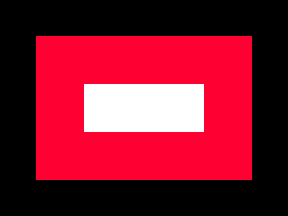![[proposed flag of Hereroland (Namibia)]](../images/n/na-herer.gif) image by Stuart Notholt,
04 Sept 1996, redrawn by Antonio
Martins, 18 Nov 1998
image by Stuart Notholt,
04 Sept 1996, redrawn by Antonio
Martins, 18 Nov 1998 
Last modified: 2014-02-14 by bruce berry
Keywords: namibia | herero | baster | upingtonia | damara | rehoboth |
Links: FOTW homepage |
search |
disclaimer and copyright |
write us |
mirrors
See also:
![[proposed flag of Hereroland (Namibia)]](../images/n/na-herer.gif) image by Stuart Notholt,
04 Sept 1996, redrawn by Antonio
Martins, 18 Nov 1998
image by Stuart Notholt,
04 Sept 1996, redrawn by Antonio
Martins, 18 Nov 1998
In 1864 a flag was designed by a British artist, Thomas Baines. It was a red
cross on a blue field with a large 4- pointed white star appearing behind it.
Although there is no evidence that the flag was officially adopted, it would
have looked much like the British Union Flag in practice.
From an article 'Other Flags of
Stuart Notholt, 04 Sept 1996
From A.P. Burgers: Sovereign flags of South Africa (1997): [bur97]
"The Damara did indeed have a flag for a while. In 1864 Charles John
Andersson, an Anglo-Swedish explorer, was elected Chief of the Damara. The flag
they adopted at this time was probably, in part, inspired by the British Union
Jack. This flag was designed for the Damara by Thomas Baines, the well-known
Africana artist, explorer and traveler of the XIX th century, who was then
painting in Damaraland. The flag was physically in use on 6 June 1864, when the
Damara forces set out under Andersson's command to do battle with their
southern neighbours, the Nama. It is also known that it was flown by them
during the battle which took place between the two forces south of
Ivan Sache, 20 November 1998
As for the "Herero" flag: this was a flag designed by Thomas
Baines for Charles John Andersson in 1864 to use during the short war against
Namaqua (another tribe of Bantu origin living in Namibia south of Damara land).
Damara and Namaqua were in continuous friction each others. When relations
between Damara and Namaqa brought to a war in 1864, the Damara people found that
the Herero (the main tribe in the Damara territory) chief Maharero was not
enough popular to lead Damara. So they offered chieftainship to Charles John
Anderson, one of the traders living in Otjimingue, where a Rhenish mission
station had been founded in 1849.
Andersson wrote in his diary (11 May 1864); "Baines suggested a National
Flag. Thought of the same thing, only did not broach the subject as it seems
almost premature... Sketch 3 or 4 different coloured flags. We must have an eye
more to effect than prettiness, as a flag, as a rule, is rarely exposed full to
view, the wind generally causing it more or less to fold, and consequently
details are lost. We tried yellow but neither creates effect nor is it clearly
visible at any distance. A red cross on a blue field, with a large star
appearing just behind the cross, looks well and effective.
My wife must make a silken standard, if I become the chief of this country. In
the meantime we ought to have something for use."
Damara won the war but with great damages and Andersson too was seriously
wounded. The "disastrous victory" ended Andersson's rule as chief of
the Damara confederation and no evidence shows his flag having been used after
22 June 1864.
It seems appropriate that the flag, incorrectly attributed to the Hereros in an
article on Baines in the SWA Yearbook of 1972, be attributed to the Damara
confederation.
Source: F.G. Brownell, "The Damara Flag of 1864" in The Flag Bulletin XXXIV:5/166
Mario Fabretto, 19 November 1998
![[proposed flag of Baster Gebiet (Namibia)]](../images/n/na-baste.gif) image by Stuart Notholt, 04 Sept 1996
image by Stuart Notholt, 04 Sept 1996
The Basters ('Bastards') are a distinctive people who speak Afrikaans and
are descended from the liaisons between Dutch speaking whites in the Cape Colony and African women. In 1868 they
trekked to their current homeland south of
from an article 'Other Flags of
Stuart Notholt, 04 Sept 1996
The book "Lost White Tribes" by Riccardo Orizio gives some
further information on the Baster/Rehoboth flag, namely:
"The Free Republic of Rehoboth, recognised by the
The article on the FOTW says that the flag may still be in use. Orizio writes
that the flag is still flown outside the Rehoboth parliament building.
Zane Whitehorn, 21 Aug 2004
 sent
by Jens Pattke, 17 Feb 2007
sent
by Jens Pattke, 17 Feb 2007
A new flag is shown on their website together with a at
http://www.rehobothbasters.org/ as
well as in Wikipedia.
Valentin Poposki, 17 Feb 2007
 image by Jens Pattke, 17 Feb 2007
image by Jens Pattke, 17 Feb 2007
I have redrawn the flag of the Rehoboth Basters based on the photographic
evidence.
Jens Pattke, 17 Feb 2007
Recent messages concerning the flag of the Rehoboth Basters prompted me to
look up this item in FOTW, where I found a rather misleading indication of the
origin of these people.
The first quotation cited states that the Basters are ". . . descended from the
liaisons between Dutch speaking whites in the Cape Colony and African women."
(from an article 'Other Flags of Namibia', by W. Smith in The Flag
Bulletin No. 145 of January - April 1992 submitted by Stuart Notholt on 04
Sept 1996).
The word "African" can be interpreted in various ways, but it usually indicates
black Africans. This was not the case here. The women in question were
mostly Khoikhoi or Bushmen – in other words the brown-skinned indigenous peoples
of Southern Africa, as opposed to the Bantu-speaking peoples who arrived within
the borders of present-day South Africa during the past 600 years. In a few
instances the women were slaves, and it is entirely uncertain what their ethnic
origin was. It is, however, unlikely that they were African, and they were more
likely Indian.
I could add that the Basters are proud of their origins and of the name
Baster, and regard themselves as being superior to Khoikhoi, Bushmen and black
Africans.
There are other Baster groupings found in other parts of Namibia, and in the
Northern Cape and Western Cape provinces, but those at Rehoboth make up the
majority of the Baster people.
Mike Oettle, 20 Feb 2007
What is known about the Upingtonia flag, a Boer state in current Namibia?
Jaume Ollé, 22 Aug 2001
Upingtonia/Lijdensrust - 1886 - Jun 1887?
20 Oct 1885 - "Republic Upingtonia" settler polity
founded.
1886 - Name changed to Lijdensrust; accepts German protection.
Jun 1887 - Republic dissolved.
President: 20 Oct 1885 - Jun 1887 George Diederik P. Prinsloo
Source: this site.
Jarig Bakker, 23 Aug 2001
 image sent
by Olivier Touzeau, 28 Oct 2002
image sent
by Olivier Touzeau, 28 Oct 2002
From a series of Cigarette Silks Iron-on Transfers, the subject of which is:
Nation Animals & Flags, the fanciful flag of German West Africa,
accompanied by a zebra.
Olivier Touzeau, 28 Oct 2002
The deviser of the cards made a double error with "German West
Africa" since there was no such colony - West Africa included the German
colonies of Togo and Cameroon - but the country intended
was no doubt German South West Africa
(Deutsch-Südwestafrika - now Namibia), since various kinds of zebra are
indigenous there. The colours of the flag are certainly German imperial, but
it's not authentic.
Mike Oettle, 15 Oct 2002